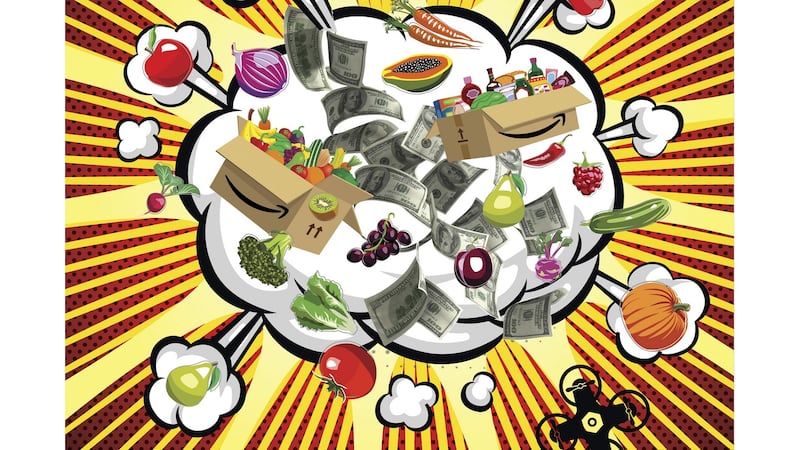It was no surprise Amazon’s deal to buy Whole Foods for $13.4 billion generated many fantastical predictions.
For instance, Amazon could use every Whole Foods store as a distribution centre or even a drone-delivery launchpad, with every order summoned by Alexa, the company's voice assistant, creating a kind of "frictionless" retail experience that would hasten its plan to – what else? – take over the world.
Sure, all of this seems plausible at some point in the future. In particular, an Amazon presence in groceries might transform it from a company you shop at every once in a while to one you think about several times a week.

This is not a novel idea. It was the key reason Walmart got into the grocery business in the 1980s, a move that accelerated its shift from a regional chain into the world’s largest physical retailer.
Yet if there's one thing to learn about Jeff Bezos, Amazon's founder and chief executive, after years of watching Amazon, it's that he doesn't spend a lot of time predicting future possibilities. He is instead consumed with improving the present reality on the ground, especially as seen through a customer's eyes.
The other thing to know about Bezos is that he is a committed experimentalist. His main way of deciding what Amazon should do next is to try stuff out, see what works, and do more of that.
So the best way to think of this deal is to look at Whole Foods as a kind of guinea pig for Amazon – a pricey, organically sourced one, perhaps, but a guinea pig all the same.
Amazon almost certainly doesn’t know yet how exactly Whole Foods will fit into its long-term plans. You can expect it to make few dramatic changes to Whole Foods in the near future.
Instead, Bezos and his team will most likely spend years meticulously analysing and tinkering with how Whole Foods works. They will begin lots of experiments. When something works, they will do more of that, then more, and then even more. They may take over the world all the same – and, in the process, probably usher in big changes to large swathes of the economy, affecting everything from labour to urban planning – but they’ll do it in ways we won’t be able to predict now.
An experiment
“I think they look at this as an opportunity to learn,” said Venky Harinarayan, an early Amazon executive who later worked at Walmart, and who also ran a venture capital firm in which Bezos was a big investor.
“It’s an experiment for everyone – I don’t know if anyone has figured out yet how to use a store to service online customers at massive scale. That’s the experimental piece.”
In this light, the Whole Foods deal starts less with a strategic end-goal and more with this insight: Shopping for food is broken. Both the in-store experience and the many attempts at online delivery – from Webvan to Instacart to Amazon’s own service, Amazon Fresh– have failed to create the sort of seamless buying experience we enjoy with nonfood e-commerce.
Shopping for food is time-consuming. Grocers have also been relatively untouched by the many customer service features we’ve come to associate with online shopping – for instance, customer reviews and recommendations.
Supermarkets are also pretty labour-intensive. Consider checking out. You have to put all your stuff in a shopping trolley, and then take everything out to scan it, and then everything has to be carefully bagged for the trip home. And then someone else comes along to collect the carts. On top of all this, the margins are low and there is a shameful amount of waste – about 10 per cent of the US food supply is wasted at the retail level, according to the US Department of Agriculture.
But online grocery delivery also isn’t so great. Delivery services tend to be far more expensive than in-store shopping, and it’s still not quite painless. You have to order ahead of time, you often have to deal with last-minute substitutions, and the whole process is still quite labour-intensive and wasteful.
And it’s not just food. In a larger sense, all physical retail needs reimagining. Competition from online commerce has gutted malls and department stores, but no one in retail believes that all physical stores are going away.
Lots of shoppers like stores, and lots of merchandise categories benefit from a physical presence: You want to try out the clothes you buy, or you want to compare the iPad's keyboard to Microsoft Surface's. So there's an opportunity for someone to figure out the future of the physical store – that it should sell, what it might look like, how it would integrate with online shopping and how it might become far friendlier than it is today.
A playground
In a single purchase, then, Whole Foods gives Amazon a playground to try out lots of ideas. Should stores be laid out more like warehouses, to optimise for online delivery? Could you make grocery checkout lines invisible, the way Amazon is trying to do with its experimental grab-and-walk-out convenience store in Seattle? Or maybe there’s some other innovation lurking in the deal that no one has thought of yet.
But wait a second, isn’t $13.4 billion a lot for an experiment? Amazon didn’t respond to a request for comment.
“No doubt it’s a big deal; it’s a large amount of money,” Harinarayan said. But he also noted that Amazon is flying high.
Like most other members of my Frightful Five collection of indomitable tech giants – Amazon, Apple, Microsoft, Facebook and Alphabet, Google's parent company – Amazon has experienced a huge growth in its stock market value over the past couple years.
The Whole Foods deal represents less than 3 per cent of its $470 billion market cap: not just a guinea pig, but a cheap one, too.
– (2017 New York Times News Service)












